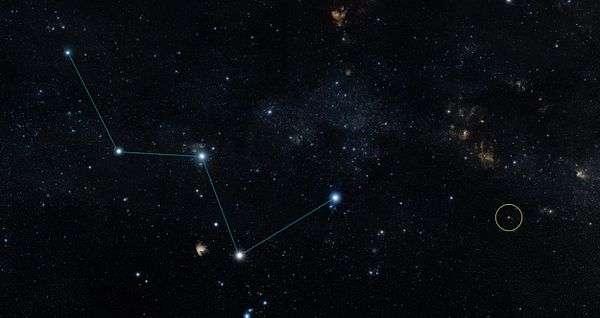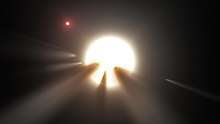HD 219134 c
HD 219134 c, also known as HR 8832 c, is a hot, dense, rocky exoplanet orbiting around the K-type star HR 8832 in the constellation of Cassiopeia. Originally thought to be a little less than three times the mass of Earth, it is now known to be over 4 times the mass and 51% larger in radius, suggesting a rocky composition with a higher quantity of iron than Earth. The exoplanet was initially detected by the instrument HARPS-N of the Italian Telescopio Nazionale Galileo via the radial velocity method. Transits of the planet were observed by the Spitzer Space Telescope in 2017. Later that year, it was predicted that HD 219134 c has an atmosphere.
| Discovery | |
|---|---|
| Discovery site | HARPS-N of the Telescopio Nazionale Galileo |
| Discovery date | 2015 July 30 |
| radial velocity method (HARPS-N); | |
| Orbital characteristics | |
| Apastron | 0.06935 (± 0.00588) AU |
| Periastron | 0.06125 (± 0.00588) AU |
| 0.06530 (± 0.0008)[1] AU | |
| Eccentricity | 0.062 (± 0.039)[1] |
| 6.76458 (± 0.00033)[1] d | |
| Inclination | 87.28 (± 0.1)[1] |
| Star | HR 8832 |
| Physical characteristics | |
Mean radius | 1.511 (± 0.047)[2]R⊕ |
| Mass | 4.36 (± 0.22)[2] M⊕ |
Mean density | 6.969 +1.08 −0.933 g cm−3 |
| 1.91 +0.23 −0.20 g | |
| Temperature | 782 K (509 °C; 948 °F)[2] |
Characteristics
Mass, Radius, and Temperature
HD 219134 c is confirmed to be a rocky Super-Earth, meaning that it has a solid surface but is significantly larger than Earth. The mass of the planet has been determined to be around 4.36 M⊕ with very low uncertainty. Its radius was found to be 1.511 R⊕ (9,627 km), once again with a small error margin. Despite being smaller in both mass and radius than its sister planet, HD 219134 c's density works out to be higher, at almost 7 g/cm3, heavily implying a rock and iron based composition, similar to the terrestrial planets in our Solar System. However, it appears to have a somewhat higher fraction of iron than Earth. The planet's gravitational pull is around 1.91g, or over 90% greater than that of Earth.[3]
Based on the planet's close proximity to the star, HD 219134 c is much hotter than Earth. It receives about 62 times the incident flux of Earth, and has an equilibrium temperature of 782 K (509 °C; 948 °F), hot enough to melt certain metals.[3] Depending on the greenhouse effect and/or the amount of cloud cover in the planet's atmosphere, its actual temperature may be significantly higher or lower.
Orbit and Rotation
HD 219134 c orbits its host star very closely, taking just 6.76 days to complete one full revolution at an orbital radius of 0.0653 AU. For comparison, the planet Mercury takes almost 88 days to orbit at a distance of 0.38 AU. Due to its close proximity to the star, the planet is likely a synchronous rotator, where one side of the planet always faces the parent star. HD 219134 c is near a 9:5 resonance with HD 219134 b and a 3:1 resonance with HD 219134 f.
Host Star
The planet orbits a (K-type) star named HR 8832, orbited by a total of five to seven planets. The star has a mass of 0.81 M☉ and a radius of 0.778 R☉. It has a temperature of 4699 K and is about 11.0 billion years old, making it one of the oldest stars. In comparison, the Sun is 4.6 billion years old[4] and has a temperature of 5778 K.[5]
The star's apparent magnitude, or how bright it appears from Earth's perspective, is 5. It can be seen with the naked eye.
Atmosphere
In 2017, it was predicted that HD 219134 c and HD 219134 b likely have atmospheres that are secondary in nature, based on the compositions of the planets and the potential for atmospheric escape. For HD 219134 c, the predicted atmosphere was calculated to reach a height of about 0.13 R⊕ (~830 km), below the predicted height of a primordial hydrogen atmosphere (0.19 R⊕). This would indicate a secondary atmosphere produced by processes like volcanic activity and evaporation of volatile materials. However, the composition of volatile materials on HD 219134 b and c could not be accurately determined, yet it is believed that HD 219134 c lacks the amount of volatiles of its sister planet and has an atmosphere more similar to the terrestrial planets of our Solar System.[6]

References
- "HD 219134 c". exoplanetarchive.ipac.caltech.edu. Retrieved 2017-12-24.
- "HD 219134". exoplanetarchive.ipac.caltech.edu. Retrieved 2017-12-26.
- Gillon, Michaël; et al. (2017). "Two massive rocky planets transiting a K-dwarf 6.5 parsecs away". Nature Astronomy. 1 (3). 0056. arXiv:1703.01430. Bibcode:2017NatAs...1E..56G. doi:10.1038/s41550-017-0056.
- Fraser Cain (16 September 2008). "How Old is the Sun?". Universe Today. Retrieved 19 February 2011.
- Fraser Cain (15 September 2008). "Temperature of the Sun". Universe Today. Retrieved 19 February 2011.
- Dorn, Caroline; Heng, Kevin (2018). "Secondary Atmospheres on HD 219134 b and C". The Astrophysical Journal. 853: 64. arXiv:1711.07745. doi:10.3847/1538-4357/aa9c80.


